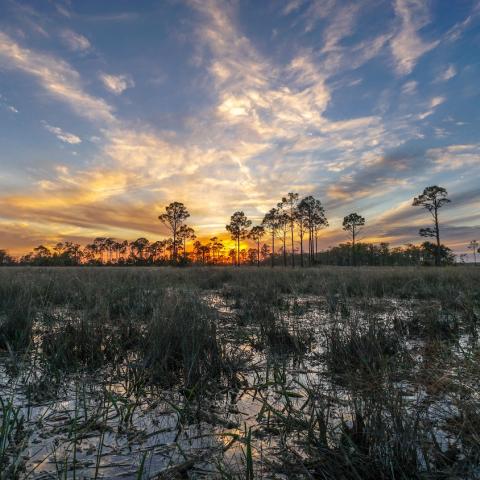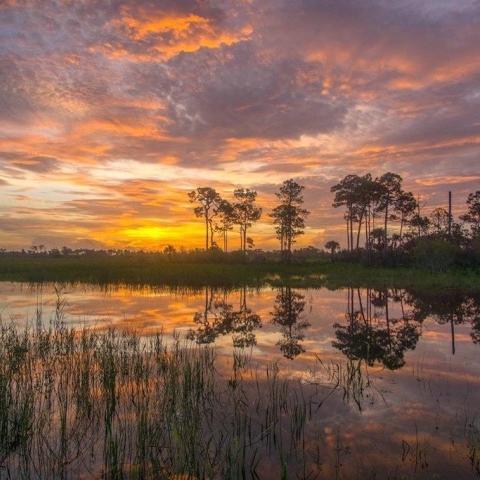In a move that baffled and angered national park advocates, the National Park Service has given the go-ahead for an oil company to explore for deposits beneath Big Cypress National Preserve in Florida, even though the company's test of its equipment was judged "clearly a failure" by park observers.
“I have honestly never been as disappointed in the Park Service as I am right now. It defies logic, that during the (Park Service) centennial and with (Interior) Secretary (Sally) Jewell just down there, that they would bend over backwards to make it as easy for this oil company to do whatever they want inside a national park," Nick Lund, the National Parks Conservation Association's point man on the issue, said Friday evening during a phone call.
"This is 70,000 acres inside the national preserve. There’s nine threatened and endangered species within the planning area, including the critically endangered Florida panther…I don’t know what NEPA (the National Environmental Policy Act) exists for if not for this thing.”
Also expressing great disappointment was Matthew Schwartz, executive director of the South Florida Wildlands Association.
"NPS has years of experience with off-road vehicles in the preserve. All of their own research indicates that this operation will likely lead to significant impacts to the preserve's natural resources," he said in an email.
Drawing the condemnation was the Park Service's announcement Friday afternoon that it had concluded that allowing Burnett Oil Co. to use seismic testing to search for oil reserves in the preserve's Nobles Grade area would have "no significant impact."
"Considering the field test and also the mitigation requirements that are outlined both in the revised EA (environmental assessment) and the FONSI (Finding of No Significant Impact), the decision is that the short-term impacts can be minimized and mitigated for," preserve spokesman Bob DeGross said during a phone call. "Following the mitigation requirements will lessen the long-term impacts.”
U.S. Sen. Bill Nelson was so concerned about the testing that in February he called on Interior Secretary Jewell to direct the Park Service to conduct a "comprehensive" review of the proposal.
“If history is any indication, approval of Burnett's request for a massive seismic survey essentially signals a green light for future drilling and fracking,” Sen. Nelson wrote in a letter to the Interior secretary. “That's why I strongly urge you to complete an Environmental Impact Statement for Burnett Oil Company's proposed seismic survey.”
But Park Service staff determined that a more extensive and involved EIS was not merited "based on information and conclusions outlined in an environmental assessment completed for the proposed survey."
At NPCA, Mr. Lund pointed out that this approval applies to 110 square miles of the preserve, and is only the first of four phases the Texas-based oil company hopes to explore.
"It's larger than Shenandoah National Park that would be explored," he said of the total footprint.
When the preserve was created, the Park Service was given the surface rights, while the mineral rights were retained by the previous owners, Mr. DeGross pointed out. "Our role is to evaluate their proposed method of accessing (those mineral rights) and then identify potential impacts and how they can be mitigated or minimized," the park spokesman said.
A year ago Burnett Oil crews tested their equipment in a small section of the preserve, a test that park observers deemed a failure in a document (attached below) that South Florida Wildlands had acquired through a Freedom of Information Act request. One of "thumper" trucks used for the experiment actually got stuck in the wet soils and crews on site had to "call for heavy equipment from a nearby oil and gas production site to come pull the vehicle out."
"One purpose for this test was to inform what the unknown impacts for this new technology may be in the wetland environment. When the environmental impacts of an action are unknown, an EIS is usually required," the park observers wrote in the document. "If the test had shown that the impacts were not significant, an EA would be justified. Since the extrapolated impacts could be significant, an EIS may be warranted."
Mr. DeGross was not familiar with the document that laid out those concerns, but said he was pretty sure that the revised EA had taken the test into consideration and called for smaller vehicles to be used during the testing.
That didn't mollify the conservation groups.
"All of their own research indicates that this operation will likely lead to significant impacts to the preserve's natural resources. Those include rutting and oxidation of fragile soils, hydrological changes due to compaction of soil, destruction of vegetation, and the spread of invasive plant species such as Brazilian pepper into parts of the preserve which may never have seen motor vehicles," Mr. Schwartz said. "We also expect disturbances to federally listed wildlife such as the Florida panther and Eastern indigo snake. Plus direct impacts to the use and enjoyment of this magnificent preserve by the public.
"Much of the land in the target area is wetlands," he added. "A good percentage has also been proposed for or is eligible for inclusion in the Federal Wilderness System. It is almost inconceivable that NPS believes it can go forward with a project of this magnitude without first preparing a full-blown Environmental Impact Statement to examine all possible impacts."
While the preserve is home to the endangered Florida panther, the U.S. Fish and Wildlife Service has never defined critical habitat for the big cat, and so how the testing might impact the panthers was not an overriding factor. Just the same, Mr. DeGross said the area being opened to seismic testing is not heavily used by panthers.
Still, he went on, "there are going to be some areas that can’t be accessed because of resource issues.”
While Mr. DeGross said the preserve's enabling legislation clearly allows for oil exploration in the park, NPCA's Mr. Lund said Big Cypress' General Management Plan allows for the agency to block a project "if it would be detrimental to the purposes of the preserve (for example, the existing regulations could not provide the level of protection necessary) or if the levels of environmental impact resulting from such operations were unacceptable (for example, the 10 percent threshold was exceeded). If the denial was viewed as a potential for the taking of property, funds would be sought from Congress to acquire the affected mineral estate."
Once the seismic testing gets underway, it will be closely monitored by park staff, said Mr. DeGross. The operators will have archaeologists and biologists with them as they’re operating, and the proposed routes that the vehicles will be take will need to be reviewed and approved by the Park Service before they go through those routes," he said.
Burnett Oil’s plan is to use sound waves created by truck-mounted vibrators to create 3-D maps of potential oil and gas reserves.
The environmental assessment only covers the seismic survey. Should Burnett Oil wish to pursue production of resources, they must submit a new plan of operations, which would undergo additional environmental review and public comment periods, the Park Service said.
Both NPCA and South Florida Wildlands officials were reviewing the options for blocking the testing.



 Support Essential Coverage of Essential Places
Support Essential Coverage of Essential Places







Comments
"When the preserve was created, the Park Service was given the surface rights, while the mineral rights were retained by the previous owners,"
And therein lies the problem.
We can also be very certain that this is not the kind of decision a park superintendent may make alone. Directions are coming from above. As for funds from Congress to acquire the affected mineral estate -- good luck on that.
So lee the owner says i will sell the surface rights but not the mineral rights. Do you forego the total preserve and say no or you do accept and preserve the surface? As usuall you make baseless accusations. There is nothing from "above" involved here.
It's been fought numerous times in state and federal courts. The mineral owner is allowed access to their "minerals". It can be delayed, but it may be wise to allow them access now and reap the possible benefit, or fight them and pay dearly with enviornmental damages.
What is shocking to me is the fact that an earlier, extremely similar, proposal for seismic surveys was proposed in the 1980's. Everyone from the superintendent, Retional Director and Director Bill Mott, agreed that an EIS would be required. When this became the position of the Department of the Interior, the seismic survey was vastly reduced and conducted solely on publlc roads.
Why is this one, with heavier epuipment and I believe more miles, allowed under an EA? The quantity of sensitive resources that will be impacted has not been reduced - in fact resource impacts will be greated.
All in all, very disappointing.
If you look carefully into the owners and operators of Burnett Oil, and follow their financial records of political contributions, more will become clear.
When I emailed Mr DeGross about the crushing destruction of Gopher Tortoise tunnels he said that "Gopher Tortoises do not live in Big Cypress Preserve ". ...Unbelievable ignorance. ... doesn't he know that FWC has an entire mandate on gopher tortoises protection, stating that they do in fact exists in every County in Florida and throughout every Terrain?
What happened to Humanity?
Ah, Esteemed Comrade, try reading the legislative history of the creation of Big Cypress. I'll not waste time trying to point anything out to you because you'll simply sidestep it. In the meantime, just prove that I and others here are wrong. Unless you can do that, your responses are "baseless." In the meantime, why not follow the advice of Follow the Money and see what you find?